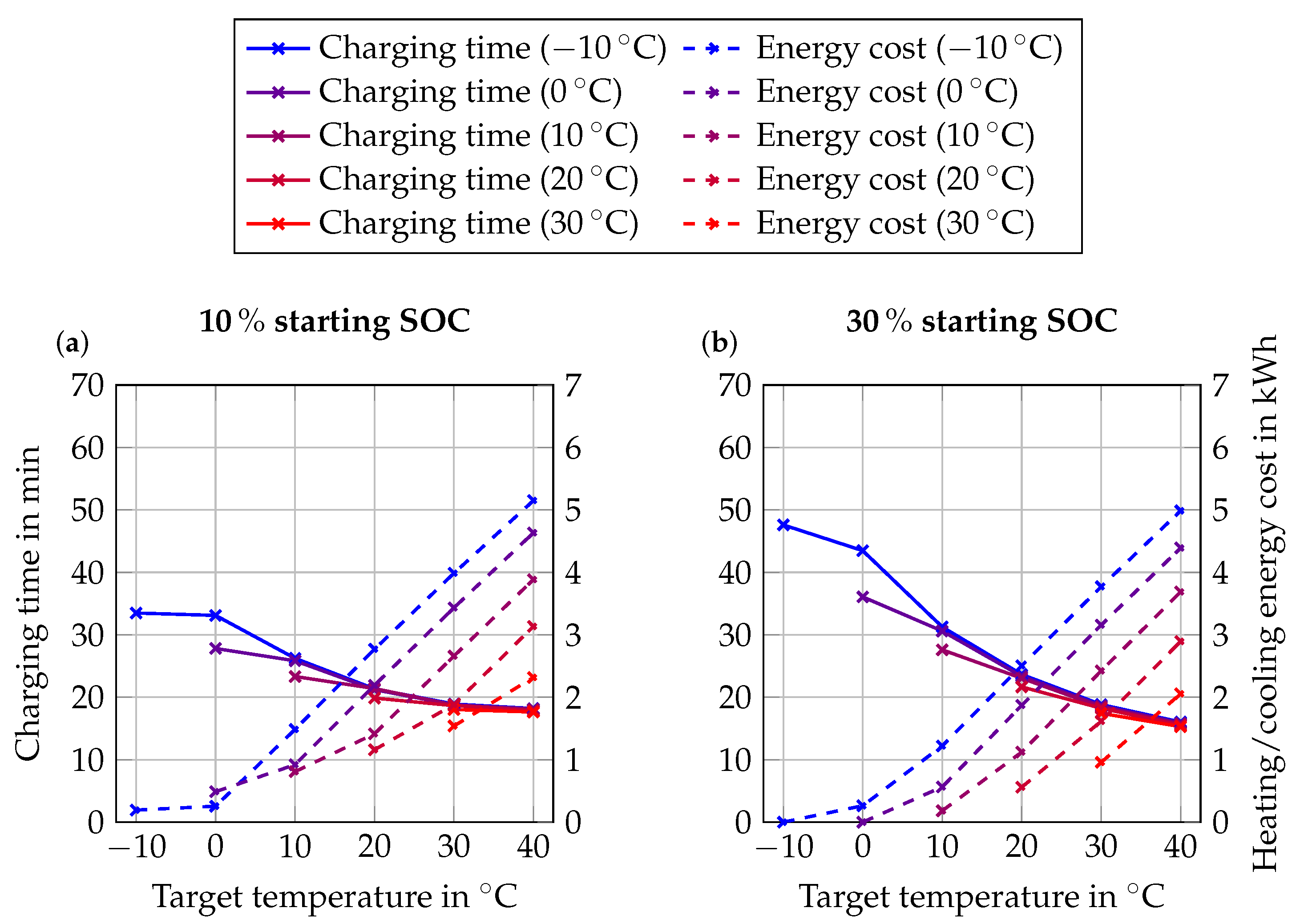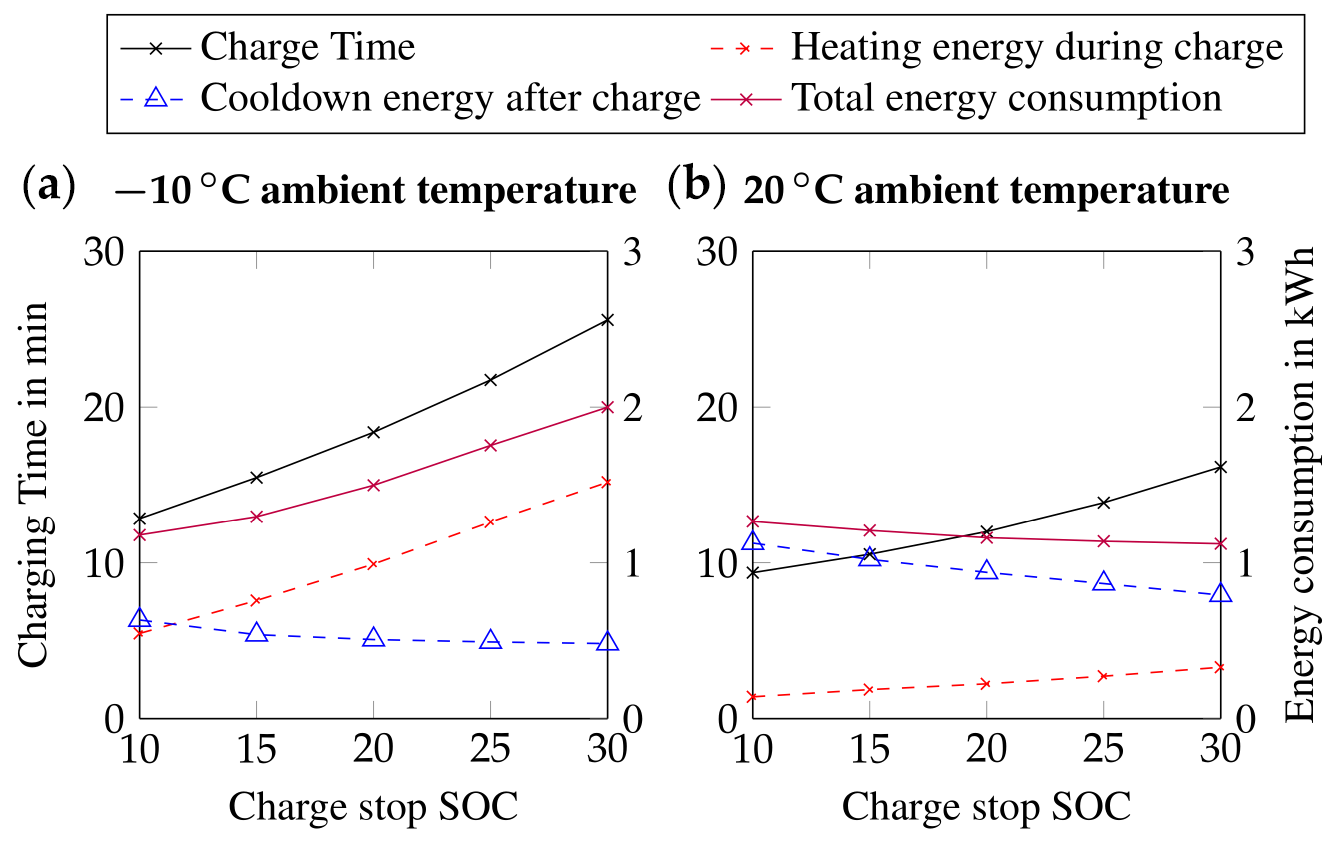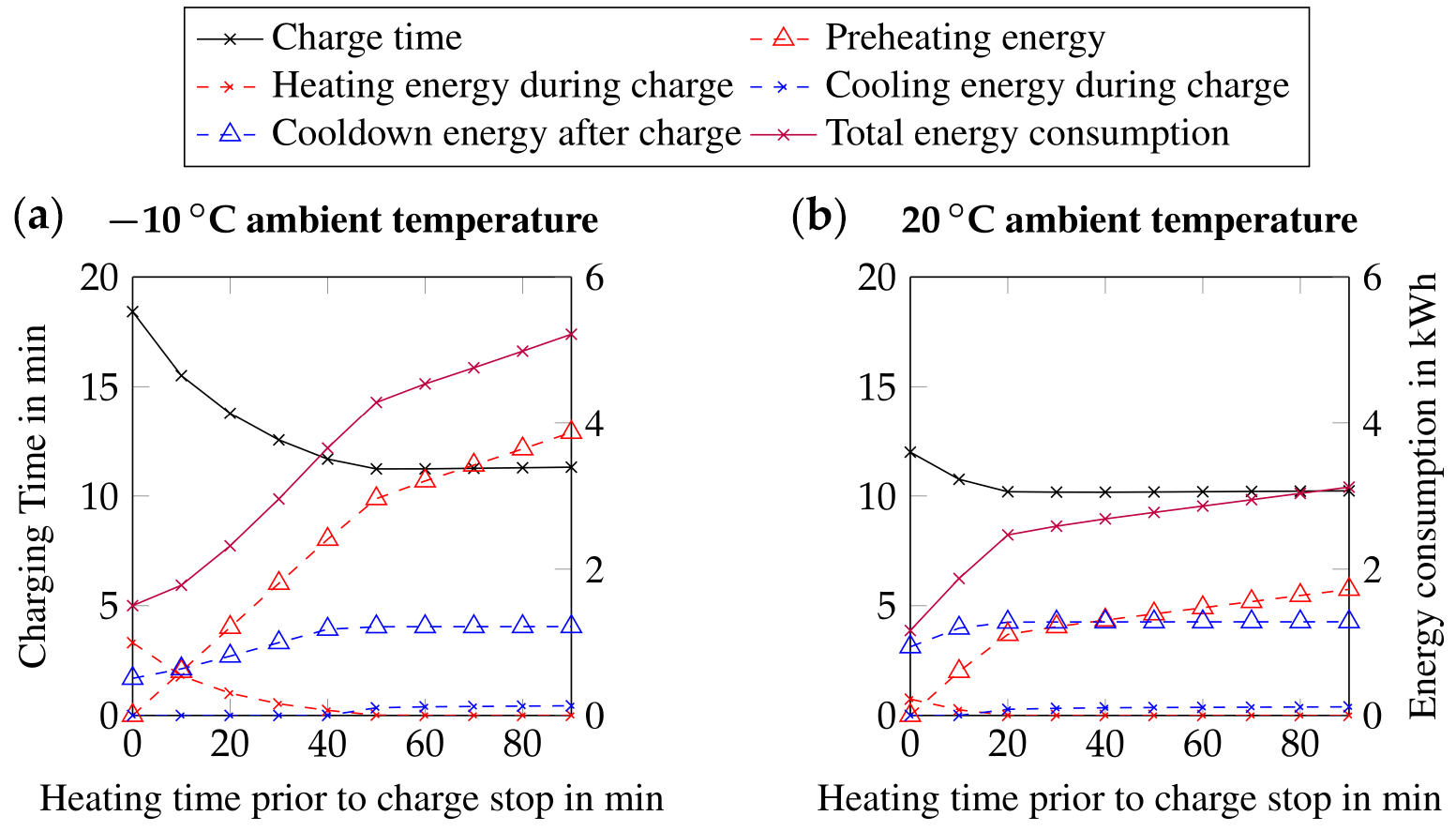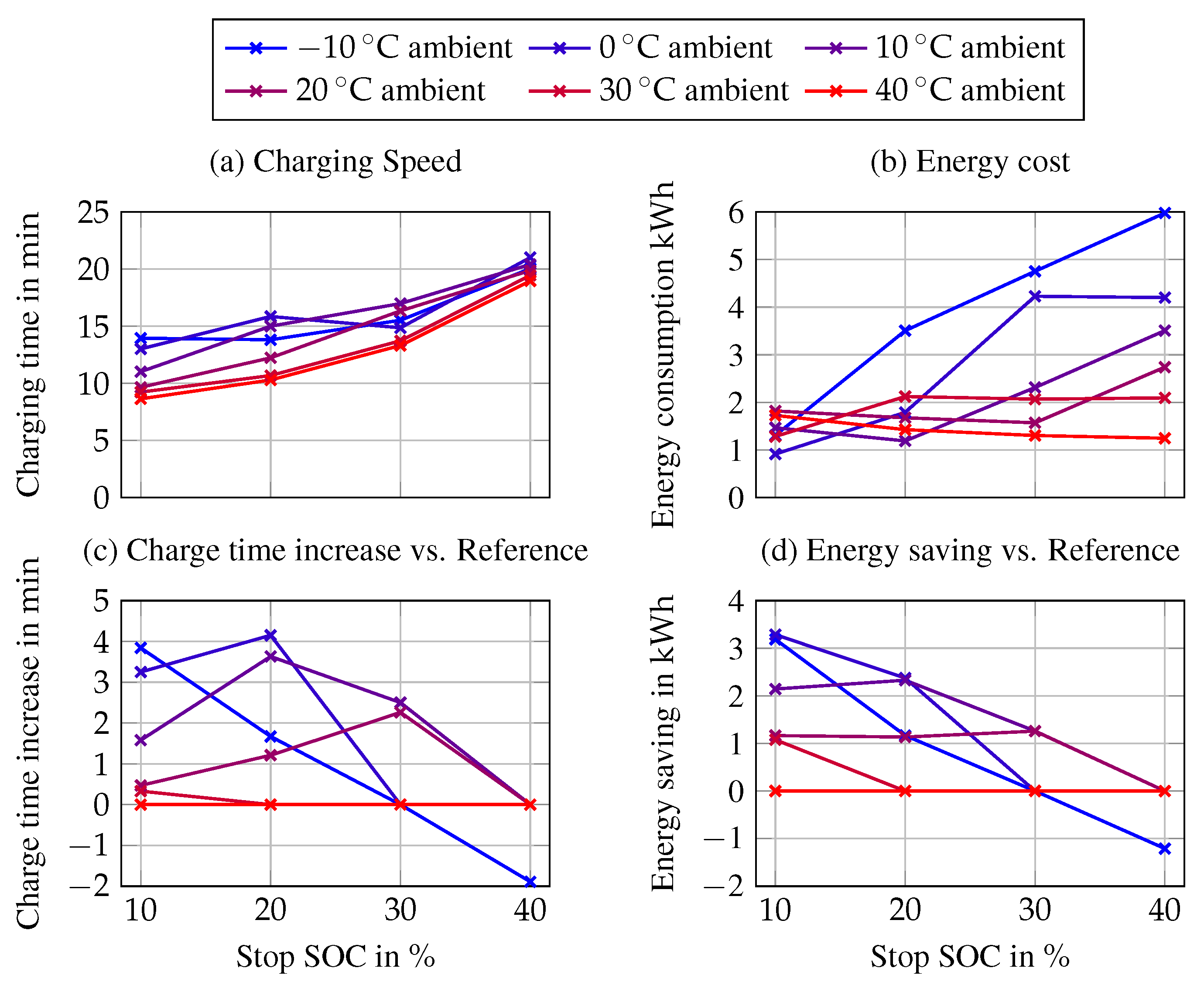Examining Model-Based Fast-Charging and Preconditioning on a Vehicle Level
Abstract
:1. Introduction
1.1. Contributions
1.2. Organization of the Article
2. Methodology
| Domain | Property | Value | Unit |
|---|---|---|---|
| Vehicle | Vehicle mass m | 1870 | kg |
| Drag coefficient | 0.288 | - | |
| Vehicle cross-section A | 2.576 | ||
| Rolling resistance coefficient | 0.015 | - | |
| Battery pack | Capacity | 65 | kWh |
| Nominal voltage | 800 | V | |
| Total cells | 7359 | - | |
| Series cells | 223 | - | |
| Parallel cells | 33 | - | |
| Heat transfer coefficient | 22.2 [36] | W/K | |
| Battery thermal management | Heater COP | 1 | - |
| Heating power per cell | 0.5 | W | |
| Cooler COP | 2 | - | |
| Cooling power per cell | 1.5 | W | |
| Cooling maximum threshold | 60 | °C | |
| Cell | Manufacturer | TerraE | - |
| Type | INR18650-25P | - | |
| Format | 18650 | - | |
| Anode material | Graphite | - | |
| Cathode material | NMC | - | |
| Rated capacity | 2.5 | Ah | |
| Voltage boundaries | 2.5–4.2 | V | |
| Nominal voltage | 3.6 | V | |
| Maximum charge rate | 4 | C |
3. Results and Discussion
3.1. Impact of Preconditioning on Charge Speed and Energy Consumption
3.2. Impact of Vehicle Velocity on Charge Speed and Energy Consumption
3.3. Proposed Thermal Management Strategy
3.3.1. Timing of Charge Stop and Preconditioning
3.3.2. Preconditioning Target Temperature
4. Conclusions
- Fast-charging should be performed at the lowest possible charge-stop SOC to prevent the increased risk of lithium plating at higher SOCs and allow for maximum self-heating during the charging process, reducing the need for external heating and thus saving energy. This is especially critical at low ambient temperatures.
- Preconditioning target temperatures should be chosen based on user preferences regarding energy cost vs. charging speed, preventing excessive energy consumption for receding charge speed benefits by leveraging the inherent self-heating during the charging process. For the battery under study, this can facilitate energy savings of over 3 kWh while only slightly impacting charging speed, which may be attractive in cost-critical use cases.
- The preconditioning process should be initialized sufficiently early to achieve the desired temperature while minimizing the time maintained at elevated temperatures to reduce energy cost and degradation while maintaining identical charging speeds. However, an additional buffer should be considered to consider uncertainties and allow for homogeneous battery heating. A preconditioning time window of 1 h appears to offer a compromise between achieving maximum charging speed without excessive energy consumption. Further examinations are required to propose optimized preconditioning timing depending on battery pack effects and ambient conditions.
- When the vehicle is operated at higher velocities, preconditioning offers diminishing charge time benefits. Vehicle manufacturers should thus take driving behavior into account when designing fast-charging strategies. For vehicles operated without active battery heating at low ambient conditions, increasing the velocity may allow for higher charging speeds but significantly increases energy costs. When active battery heating is available, higher vehicle velocities offer no benefit towards charge duration.
- Charging speed and energy efficiency can be significantly increased by installing dedicated battery heaters, such as utilizing the vehicle heat pump. This has to be weighed against potential increases in weight, complexity, and cost, posing a design trade-off for vehicle manufacturers to consider depending on the concrete use case.
Author Contributions
Funding
Data Availability Statement
Acknowledgments
Conflicts of Interest
Abbreviations
| BEV | battery electric vehicle |
| COP | coefficient of performance |
| SOC | state-of-charge |
| WLTP | Worldwide Harmonized Light Vehicles Test Procedure |
References
- Dufek, E.J.; Abraham, D.P.; Bloom, I.; Chen, B.R.; Chinnam, P.R.; Colclasure, A.M.; Gering, K.L.; Keyser, M.; Kim, S.; Mai, W.; et al. Developing extreme fast charge battery protocols—A review spanning materials to systems. J. Power Sources 2022, 526, 231129. [Google Scholar] [CrossRef]
- Tomaszewska, A.; Chu, Z.; Feng, X.; O’Kane, S.; Liu, X.; Chen, J.; Ji, C.; Endler, E.; Li, R.; Liu, L.; et al. Lithium-ion battery fast charging: A review. eTransportation 2019, 1, 100011. [Google Scholar] [CrossRef]
- Thapa, A.; Hedding, N.; Gao, H. Fast charging of commercial lithium-ion battery without lithium plating. J. Energy Storage 2023, 74, 109524. [Google Scholar] [CrossRef]
- Liu, C.; Gao, Y.; Liu, L. Toward safe and rapid battery charging: Design optimal fast charging strategies thorough a physics–based model considering lithium plating. Int. J. Energy Res. 2021, 45, 2303–2320. [Google Scholar] [CrossRef]
- Yang, S.; Gao, X.; Li, Y.; Xie, W.; Guo, B.; Zhang, L.; Liu, X. Minimum lithium plating overpotential control based charging strategy for parallel battery module prevents side reactions. J. Power Sources 2021, 494, 229772. [Google Scholar] [CrossRef]
- Pegel, H.; Wycisk, D.; Scheible, A.; Tendera, L.; Latz, A.; Sauer, D.U. Fast-charging performance and optimal thermal management of large-format full-tab cylindrical lithium-ion cells under varying environmental conditions. J. Power Sources 2023, 556, 232408. [Google Scholar] [CrossRef]
- Motoaki, Y.; Yi, W.; Salisbury, S. Empirical analysis of electric vehicle fast charging under cold temperatures. Energy Policy 2018, 122, 162–168. [Google Scholar] [CrossRef]
- Liu, T.; Ge, S.; Yang, X.G.; Wang, C.Y. Effect of thermal environments on fast charging Li-ion batteries. J. Power Sources 2021, 511, 230466. [Google Scholar] [CrossRef]
- Abo Gamra, K.; Wassiliadis, N.; Allgäuer, C.; Lienkamp, M. Revealing the effect of initial conditions and the potential of self-heating versus active heating on fast-charged lithium-ion batteries. J. Energy Storage 2024, 84, 110968. [Google Scholar] [CrossRef]
- Yang, X.G.; Wang, C.Y. Understanding the trilemma of fast charging, energy density and cycle life of lithium-ion batteries. J. Power Sources 2018, 402, 489–498. [Google Scholar] [CrossRef]
- Abo Gamra, K.; Zähringer, M.; Allgäuer, C.; Lienkamp, M. Examining Model-Based Fast-Charging on Vehicle-Level. In Proceedings of the EVS37 International Electric Vehicle Symposium and Exhibition, Seoul, Republic of Korea, 23–26 April 20204. [Google Scholar]
- Hu, X.; Zheng, Y.; Howey, D.A.; Perez, H.; Foley, A.; Pecht, M. Battery warm-up methodologies at subzero temperatures for automotive applications: Recent advances and perspectives. Prog. Energy Combust. Sci. 2020, 77, 100806. [Google Scholar] [CrossRef]
- Burnham, A.; Dufek, E.J.; Stephens, T.; Francfort, J.; Michelbacher, C.; Carlson, R.B.; Zhang, J.; Vijayagopal, R.; Dias, F.; Mohanpurkar, M.; et al. Enabling fast charging—Infrastructure and economic considerations. J. Power Sources 2017, 367, 237–249. [Google Scholar] [CrossRef]
- Keyser, M.; Pesaran, A.; Li, Q.; Santhanagopalan, S.; Smith, K.; Wood, E.; Ahmed, S.; Bloom, I.; Dufek, E.; Shirk, M.; et al. Enabling fast charging—Battery thermal considerations. J. Power Sources 2017, 367, 228–236. [Google Scholar] [CrossRef]
- Meintz, A.; Zhang, J.; Vijayagopal, R.; Kreutzer, C.; Ahmed, S.; Bloom, I.; Burnham, A.; Carlson, R.B.; Dias, F.; Dufek, E.J.; et al. Enabling fast charging—Vehicle considerations. J. Power Sources 2017, 367, 216–227. [Google Scholar] [CrossRef]
- Yin, Y.; Hu, Y.; Choe, S.Y.; Cho, H.; Joe, W.T. New fast charging method of lithium-ion batteries based on a reduced order electrochemical model considering side reaction. J. Power Sources 2019, 423, 367–379. [Google Scholar] [CrossRef]
- Yin, Y.; Choe, S.Y. Actively temperature controlled health-aware fast charging method for lithium-ion battery using nonlinear model predictive control. Appl. Energy 2020, 271, 115232. [Google Scholar] [CrossRef]
- Wang, Y.; Mao, S.; Chen, Q.; Chen, F.; Zhang, X.; Ouyang, M.; Han, X.; Zheng, Y. Online Fast Charging Model without Lithium Plating for Long-Dimensional Cells in Automotive Applications. Batteries 2023, 9, 563. [Google Scholar] [CrossRef]
- Hamednia, A.; Murgovski, N.; Fredriksson, J.; Forsman, J.; Pourabdollah, M.; Larsson, V. Optimal Thermal Management, Charging, and Eco-Driving of Battery Electric Vehicles. IEEE Trans. Veh. Technol. 2023, 72, 7265–7278. [Google Scholar] [CrossRef]
- Hamednia, A.; Hanson, V.; Zhao, J.; Murgovski, N.; Forsman, J.; Pourabdollah, M.; Larsson, V.; Fredriksson, J. Charge Planning and Thermal Management of Battery Electric Vehicles. IEEE Trans. Veh. Technol. 2023, 72, 14141–14154. [Google Scholar] [CrossRef]
- Zhu, T.; Min, H.; Yu, Y.; Zhao, Z.; Xu, T.; Chen, Y.; Li, X.; Zhang, C. An Optimized Energy Management Strategy for Preheating Vehicle-Mounted Li-ion Batteries at Subzero Temperatures. Energies 2017, 10, 243. [Google Scholar] [CrossRef]
- Zhang, Z.; Min, H.; Yu, Y.; Cao, Q.; Li, M.; Yan, K. An optimal thermal management system heating control strategy for electric vehicles under low-temperature fast charging conditions. Appl. Therm. Eng. 2022, 207, 118123. [Google Scholar] [CrossRef]
- Abbasi, M.H.; Arjmandzadeh, Z.; Zhang, J.; Xu, B.; Krovi, V. Deep reinforcement learning based fast charging and thermal management optimization of an electric vehicle battery pack. J. Energy Storage 2024, 95, 112466. [Google Scholar] [CrossRef]
- Acker, L.; Trunner, E.; Hofmann, P. Optimal Battery Thermal Management During and Prior to Fast Charging using Dynamic Programming. In Proceedings of the 2024 IEEE Transportation Electrification Conference and Expo (ITEC), Chicago, IL, USA, 19–21 June 2024; pp. 1–8. [Google Scholar] [CrossRef]
- Hu, Q.; Amini, M.R.; Wiese, A.; Seeds, J.B.; Kolmanovsky, I.; Sun, J. Electric Vehicle Enhanced Fast Charging Enabled by Battery Thermal Management and Model Predictive Control. IFAC-Pap. 2023, 56, 10684–10689. [Google Scholar] [CrossRef]
- Hu, Q.; Amini, M.R.; Wiese, A.; Kolmanovsky, I.; Sun, J. Robust Model Predictive Control for Enhanced Fast Charging on Electric Vehicles through Integrated Power and Thermal Management. In Proceedings of the 2023 62nd IEEE Conference on Decision and Control (CDC), Singapore, 13–15 December 2023; pp. 5267–5272. [Google Scholar] [CrossRef]
- Kumar Thakur, A.; Sathyamurthy, R.; Velraj, R.; Saidur, R.; Pandey, A.K.; Ma, Z.; Singh, P.; Hazra, S.K.; Wafa Sharshir, S.; Prabakaran, R.; et al. A state-of-the art review on advancing battery thermal management systems for fast-charging. Appl. Therm. Eng. 2023, 226, 120303. [Google Scholar] [CrossRef]
- Hu, L.; Dong, J.; Lin, Z. Modeling charging behavior of battery electric vehicle drivers: A cumulative prospect theory based approach. Transp. Res. Part C Emerg. Technol. 2019, 102, 474–489. [Google Scholar] [CrossRef]
- Franke, T.; Krems, J.F. Understanding charging behaviour of electric vehicle users. Transp. Res. Part F Traffic Psychol. Behav. 2013, 21, 75–89. [Google Scholar] [CrossRef]
- Zhang, B.; Niu, N.; Li, H.; Wang, Z.; He, W. Could fast battery charging effectively mitigate range anxiety in electric vehicle usage?Evidence from large-scale data on travel and charging in Beijing. Transp. Res. Part D Transp. Environ. 2021, 95, 102840. [Google Scholar] [CrossRef]
- Yang, Y.; Tan, Z.; Ren, Y. Research on Factors That Influence the Fast Charging Behavior of Private Battery Electric Vehicles. Sustainability 2020, 12, 3439. [Google Scholar] [CrossRef]
- Batemo GmbH. TerraE INR18650-25P. Available online: https://www.batemo.com/products/batemo-cell-explorer/terrae-inr18650-25p/#get-report-popup (accessed on 18 July 2024).
- Wassiliadis, N.; Kriegler, J.; Abo Gamra, K.; Lienkamp, M. Model-based health-aware fast charging to mitigate the risk of lithium plating and prolong the cycle life of lithium-ion batteries in electric vehicles. J. Power Sources 2023, 561, 232586. [Google Scholar] [CrossRef]
- Wang, Y.; Zhang, X.; Chen, Z. Low temperature preheating techniques for Lithium-ion batteries: Recent advances and future challenges. Appl. Energy 2022, 313, 118832. [Google Scholar] [CrossRef]
- Wang, Z.; Du, C. A comprehensive review on thermal management systems for power lithium-ion batteries. Renew. Sustain. Energy Rev. 2021, 139, 110685. [Google Scholar] [CrossRef]
- Rosenberger, N.; Rosner, P.; Bilfinger, P.; Schöberl, J.; Teichert, O.; Schneider, J.; Abo Gamra, K.; Allgäuer, C.; Dietermann, B.; Schreiber, M.; et al. Quantifying the State of the Art of Electric Powertrains in Battery Electric Vehicles: Comprehensive Analysis of the Tesla Model 3 on the Vehicle Level. World Electr. Veh. J. 2024, 15, 268. [Google Scholar] [CrossRef]
- Lain, M.J.; Brandon, J.; Kendrick, E. Design Strategies for High Power vs. High Energy Lithium Ion Cells. Batteries 2019, 5, 64. [Google Scholar] [CrossRef]
- Buidin, T.I.C.; Mariasiu, F. Parametric Evaluation of Thermal Behavior for Different Li-Ion Battery Chemistries. Batteries 2022, 8, 291. [Google Scholar] [CrossRef]
- Hales, A.; Diaz, L.B.; Marzook, M.W.; Zhao, Y.; Patel, Y.; Offer, G. The Cell Cooling Coefficient: A Standard to Define Heat Rejection from Lithium-Ion Batteries. J. Electrochem. Soc. 2019, 166, A2383–A2395. [Google Scholar] [CrossRef]
- Pegel, H.; Wycisk, D.; Sauer, D.U. Influence of cell dimensions and housing material on the energy density and fast-charging performance of tabless cylindrical lithium-ion cells. Energy Storage Mater. 2023, 60, 102796. [Google Scholar] [CrossRef]
- Cussigh, M.; Hamacher, T. Optimal Charging and Driving Strategies for Battery Electric Vehicles on Long Distance Trips: A Dynamic Programming Approach; IEEE: Piscataway, NJ, USA, 2019. [Google Scholar] [CrossRef]
- Kucukoglu, I.; Dewil, R.; Cattrysse, D. The electric vehicle routing problem and its variations: A literature review. Comput. Ind. Eng. 2021, 161, 107650. [Google Scholar] [CrossRef]
- Liu, X.; Ai, W.; Naylor Marlow, M.; Patel, Y.; Wu, B. The effect of cell-to-cell variations and thermal gradients on the performance and degradation of lithium-ion battery packs. Appl. Energy 2019, 248, 489–499. [Google Scholar] [CrossRef]








| SOC | 20% SOC | 30% SOC | 40% SOC | |
|---|---|---|---|---|
| °C ambient | 10 °C | 30 °C | 40 °C | 50 °C |
| °C ambient | 10 °C | 20 °C | 40 °C | 40 °C |
| °C ambient | 20 °C | 20 °C | 30 °C | 40 °C |
| °C ambient | 30 °C | 30 °C | 30 °C | 40 °C |
| °C ambient | - | 40 °C | 40 °C | 40 °C |
| °C ambient | - | - | - | - |
Disclaimer/Publisher’s Note: The statements, opinions and data contained in all publications are solely those of the individual author(s) and contributor(s) and not of MDPI and/or the editor(s). MDPI and/or the editor(s) disclaim responsibility for any injury to people or property resulting from any ideas, methods, instructions or products referred to in the content. |
© 2024 by the authors. Licensee MDPI, Basel, Switzerland. This article is an open access article distributed under the terms and conditions of the Creative Commons Attribution (CC BY) license (https://creativecommons.org/licenses/by/4.0/).
Share and Cite
Abo Gamra, K.; Zähringer, M.; Ladner, A.; Allgäuer, C.; Lienkamp, M. Examining Model-Based Fast-Charging and Preconditioning on a Vehicle Level. World Electr. Veh. J. 2024, 15, 377. https://doi.org/10.3390/wevj15080377
Abo Gamra K, Zähringer M, Ladner A, Allgäuer C, Lienkamp M. Examining Model-Based Fast-Charging and Preconditioning on a Vehicle Level. World Electric Vehicle Journal. 2024; 15(8):377. https://doi.org/10.3390/wevj15080377
Chicago/Turabian StyleAbo Gamra, Kareem, Maximilian Zähringer, Aaron Ladner, Christian Allgäuer, and Markus Lienkamp. 2024. "Examining Model-Based Fast-Charging and Preconditioning on a Vehicle Level" World Electric Vehicle Journal 15, no. 8: 377. https://doi.org/10.3390/wevj15080377
APA StyleAbo Gamra, K., Zähringer, M., Ladner, A., Allgäuer, C., & Lienkamp, M. (2024). Examining Model-Based Fast-Charging and Preconditioning on a Vehicle Level. World Electric Vehicle Journal, 15(8), 377. https://doi.org/10.3390/wevj15080377







